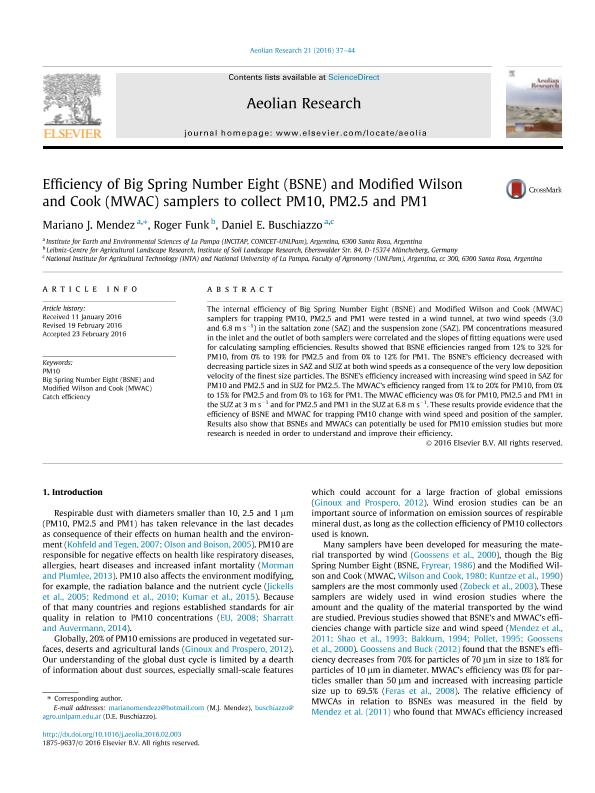Artículo
Efficiency of Big Spring Number Eight (BSNE) and Modified Wilson and Cook (MWAC) samplers to collect PM10, PM2.5 and PM1
Fecha de publicación:
03/2016
Editorial:
Elsevier Science
Revista:
Aeolian Research
ISSN:
1875-9637
Idioma:
Inglés
Tipo de recurso:
Artículo publicado
Clasificación temática:
Resumen
The internal efficiency of Big Spring Number Eight (BSNE) and Modified Wilson and Cook (MWAC) samplers for trapping PM10, PM2.5 and PM1 were tested in a wind tunnel, at two wind speeds (3.0 and 6.8 m s−1) in the saltation zone (SAZ) and the suspension zone (SAZ). PM concentrations measured in the inlet and the outlet of both samplers were correlated and the slopes of fitting equations were used for calculating sampling efficiencies. Results showed that BSNE efficiencies ranged from 12% to 32% for PM10, from 0% to 19% for PM2.5 and from 0% to 12% for PM1. The BSNE’s efficiency decreased with decreasing particle sizes in SAZ and SUZ at both wind speeds as a consequence of the very low deposition velocity of the finest size particles. The BSNE’s efficiency increased with increasing wind speed in SAZ for PM10 and PM2.5 and in SUZ for PM2.5. The MWAC’s efficiency ranged from 1% to 20% for PM10, from 0% to 15% for PM2.5 and from 0% to 16% for PM1. The MWAC efficiency was 0% for PM10, PM2.5 and PM1 in the SUZ at 3 m s−1 and for PM2.5 and PM1 in the SUZ at 6.8 m s−1. These results provide evidence that the efficiency of BSNE and MWAC for trapping PM10 change with wind speed and position of the sampler. Results also show that BSNEs and MWACs can potentially be used for PM10 emission studies but more research is needed in order to understand and improve their efficiency.
Archivos asociados
Licencia
Identificadores
Colecciones
Articulos(INCITAP)
Articulos de INST.D/CS D/L/TIERRA Y AMBIENTALES D/L/PAMPA
Articulos de INST.D/CS D/L/TIERRA Y AMBIENTALES D/L/PAMPA
Citación
Mendez, Mariano Javier; Funk, Roger; Buschiazzo, Daniel Eduardo; Efficiency of Big Spring Number Eight (BSNE) and Modified Wilson and Cook (MWAC) samplers to collect PM10, PM2.5 and PM1; Elsevier Science; Aeolian Research; 21; 3-2016; 37-44
Compartir
Altmétricas




